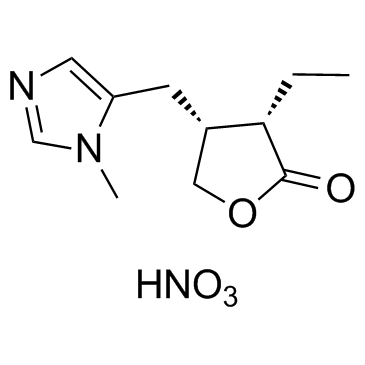148-72-1
| Name | Pilocarpine nitrate salt |
|---|---|
| Synonyms |
MFCD00078497
(3S,4R)-3-Ethyl-4-((1-methyl-1H-imidazol-5-yl)methyl)dihydrofuran-2(3H)-one nitrate Pilocarpine nitrate EINECS 205-723-7 |
| Description | Pilocarpine nitrate is a selective M3-type muscarinic acetylcholine receptor (M3 muscarinic receptor) agonist. |
|---|---|
| Related Catalog | |
| Target |
M3 muscarinic receptor[1] |
| In Vitro | To evaluate the cytotoxicity of Pilocarpine, the morphology and viability of human corneal stromal (HCS) cells are examined by light microscopy and MTT assay, respectively. Morphological observations show that HCS cells exposed to Pilocarpine at a concentration from 0.625 to 20 g/L exhibit dose- and time-dependent proliferation retardation and morphological abnormality such as cellular shrinkage, cytoplasmic vacuolation, detachment from culture matrix, and eventually death, while no obvious difference is observed between those exposed to Pilocarpine below the concentration of 0.625 g/L and controls. Results of MTT assay reveal that the cell viability of HCS cells decrease with time and concentration after exposing to Pilocarpine above the concentration of 0.625 g/L (P<0.01 or 0.05), while that of HCS cells treated with Pilocarpine below the concentration of 0.625 g/L show no significant difference to controls[2]. The partial muscarinic agonist, Pilocarpine, evokes concentration-dependent relaxation with an EC50 of 2.4 mM in isolated segments of rat tail artery that were constricted with Penylephrine (10 to 200 nM)[3]. |
| In Vivo | The Pilocarpine-induced saliva secretion of the control rats (CN) and exercised (EX) rats is examined. A significantly greater amount of saliva is induced by Pilocarpine in the EX rats than in the CN rats (P<0.01). Conversely, the Na+ concentration in the saliva of the EX rats is significantly lower than that of the CN rats (P<0.05)[1]. |
| Cell Assay | Cell viability is determined by MTT assay. Briefly, HCS cells are inoculated into a 96-well culture plate (Nunc) at a density of 1×104 cells/100 µL/well, and are cultured and treated. At a 4h interval, the Pilocarpine (0.625 to 20 g/L)-containing medium is replaced entirely with 100 µL serum-free DMEM/F12 medium containing 1.0 g/L MTT, and the cells are incubated at 37°C in the dark for 4h. After the MTT-containing medium is discarded with caution, 150 µL DMSO is added to dissolve the produced formazan crystals at 37°C in the dark for 15 min, and the absorbance at 490 nm is measured with a Multiskan GO microplate reader[2]. |
| Animal Admin | Rats[1] Male, 10-week-old Wistar rats are assigned to one of two groups, exercise (EX, n=6) and control (CN, n=6). The EX rats are kept for 40 days in cages with a running wheel (SN-451), allowing them to undertake voluntary exercise, while the CN rats are kept in cages with the running wheel locked. On the 40th day, Pilocarpine-induced saliva is measured as follows. Briefly, the rats are anesthetized, preweighed cotton was placed in their mouths sublingually, and Pilocarpine (0.5 mg/kg) is intraperitoneally injected to induce saliva secretion. Each cotton ball is then changed every 10 min for 1 h. The collected cotton balls are weighed again, and the mass of saliva secreted is calculated by subtracting the initial from the final weight. |
| References |
| Boiling Point | 520.5ºC at 760 mmHg |
|---|---|
| Melting Point | 173,5-174°C |
| Molecular Formula | C11H17N3O5 |
| Molecular Weight | 271.27000 |
| Flash Point | 268.6ºC |
| Exact Mass | 271.11700 |
| PSA | 110.17000 |
| LogP | 1.33730 |
| Vapour Pressure | 1.16E-11mmHg at 25°C |
| Index of Refraction | 81 ° (C=2, H2O) |
| Storage condition | 2-8°C |
| Water Solubility | H2O: 0.1 g/mL, clear, very faintly yellow |
CHEMICAL IDENTIFICATION
HEALTH HAZARD DATAACUTE TOXICITY DATA
MUTATION DATA
|
| Symbol |

GHS06 |
|---|---|
| Signal Word | Danger |
| Hazard Statements | H300 + H330 |
| Precautionary Statements | Missing Phrase - N15.00950417-P260-P304 + P340 + P310-P403 + P233 |
| Personal Protective Equipment | Eyeshields;Faceshields;full-face particle respirator type N100 (US);Gloves;respirator cartridge type N100 (US);type P1 (EN143) respirator filter;type P3 (EN 143) respirator cartridges |
| Hazard Codes | Xn: Harmful; |
| Risk Phrases | R22 |
| Safety Phrases | S1-S25-S45 |
| RIDADR | 3087 |
| WGK Germany | 3 |
| RTECS | TK1455000 |
| Packaging Group | III |
| Hazard Class | 6.1(b) |
| HS Code | 2934999090 |
|
~% 
148-72-1 |
| Literature: Tetrahedron, , vol. 65, # 39 p. 8283 - 8296 |
| HS Code | 2934999090 |
|---|---|
| Summary | 2934999090. other heterocyclic compounds. VAT:17.0%. Tax rebate rate:13.0%. . MFN tariff:6.5%. General tariff:20.0% |
